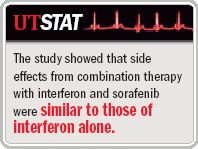Article
Studies document new agent's efficacy in advanced RCC
Author(s):
Atlanta-Two recent studies have provided promising outcomes data on sorafenib tosylate (Nexavar), both as a second-line therapy and potentially as first-line treatment in patients with advanced renal cell carcinoma, researchers reported at the American Society of Clinical Oncology annual meeting here.

In the first report, Tim Eisen, PhD, presented an update on a randomized phase III trial of sorafenib in advanced RCC and data on the survival impact on of crossover from placebo to sorafenib in patients who had progressed after first-line treatment in the preceding 8 months. Dr. Eisen participated in this research while a consultant medical oncologist at Royal Marsden Hospital in London; he is currently professor of medical oncology at Cambridge University.
An earlier phase II randomized discontinuation study had shown that treatment with sora-fenib improves progression-free survival when used as a second-line therapy.
"Sorafenib will result in a survival advantage of around 2 to 3 months compared to placebo in the second-line setting," commented David I. Quinn, MD, PhD, assistant professor of medicine at the University of Southern California, Los Angeles, and invited discussant of the ASCO session. "Patients switching from placebo to sorafenib had a very high rate of disease control, suggesting that timing of therapy is not absolutely crucial provided the patient has time to respond."
"It was very encouraging to hear the discussant be less cautious than I was, which is usually not the way," Dr. Eisen responded. "The ideal thing from my point of view is to see that the overall survival benefit of about 30% for patients receiving sorefanib is maintained.
"Many combination clinical studies are planned. Sorafenib is a well-tolerated agent as a single agent, although its cost is significant. The cost of combination therapies will be even more significant. For cost-conscious health economies like Britain's and also many other countries in Europe, that is an issue. We will need fantastic results to justify a $6,000-a-month treatment."
Response rate of 18%
In a second presentation, Christopher W. Ryan, MD, assistant professor of hematology and oncology, Oregon Health and Sciences University, Portland, reported on a relatively small phase II Southwest Oncology Group study in which interferon was combined with sorafenib to simultaneously target antiangiogenic and MAP kinase pathways.
Sixty-one patients (40 male; median age, 62 years) were enrolled; 86% had prior nephrectomy. They were treated at 22 different institutions, including community-based oncology practices belonging to the Southwest Oncology Group.
There was an overall response rate of 18%, higher than reported for either single agent previously. The study also showed that the combination's side effects were similar to those of interferon, substantially more than sorafenib would have by itself.
With a median follow-up of 12 months, the 6-month overall survival rate was 89%, with 26% remaining on treatment at the time of the presentation in early June. The overall response rate of 18% for the combination of sorafenib and interferon in advanced RCC was greater than expected with either interferon or sorafenib alone. Toxicities typical of interferon affected more than half of the patients. However, hand-foot syndrome, a common side effect of sorafenib, was seen in only 13%.
"Based on other studies, this may mean that interferon by itself will not be considered a very useful treatment for renal carcinoma because of superiority shown with other agents. However, it remains an intriguing and active drug for renal cell carcinoma with potential for continued use in combination with some of these new drugs," Dr. Ryan said.
Promising combination
Discussing Dr. Ryan's report, Dr. Quinn agreed that adding interferon to sorafenib may increase response rate and, possibly, time to progression, but it does so at the cost of significant, chronic side effects that can be attributed to interferon.





